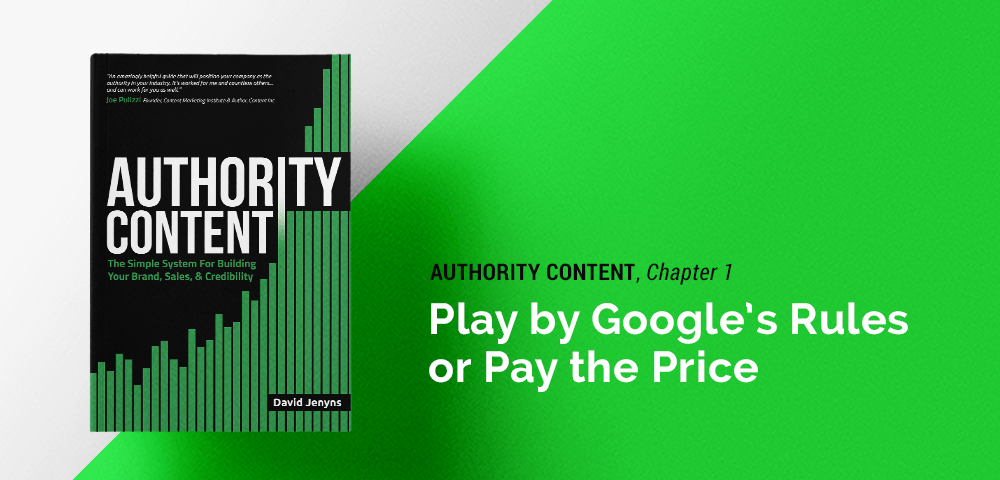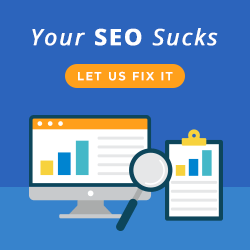With competition to reach the top ranking in Google stronger than ever before, some businesses will do whatever it takes to get their website seen. But when you don’t do things in the right way and abuse the system, Google takes notice.
It can be easy to forget just why you are in business in the first place, when you spend more time worrying about backlinks and getting your marketing messages heard than you do about actually serving your customers.
So, what if we told you there was a book that lets you in on a step-by-step process that could increase your chance of success and your ROI? Without resorting to methods that could get your site penalised?
Authority Content by David Jenyns provides a powerful yet simple strategy that will help you to build authority in your industry and improve your website traffic and sales. Here is a quick intro video from the book launch:
We are delighted to be able to share the first chapter from the book entitled ‘Predicting the Future’.
This chapter covers:
- Understanding the evolution of the internet and how your business should be evolving with it.
- How Google and other platforms are there to serve their users, not your business.
- Remembering why are in business and who you are trying to serve.
- Why tricking Google’s algorithm is a bad idea.
Let’s take a look!
CHAPTER 1: PREDICTING THE FUTURE
This is the part of the book that, if I’m not careful, could date faster than any other section.
It’s important we talk about how the Internet as a medium has changed over the years and how the ways in which people interact with it are altering. But there’s almost nothing I can say about how the Internet currently operates that doesn’t risk becoming out-dated by the time you read this book.
I could try to offset this problem by throwing in a few predictions, but I’m not Nostradamus and I prefer to focus on fundamental truths. The rate of change in technology and online advancement has now increased to a point where it’s actually quite risky to gamble on the short- term. And the Internet is littered with enough comments from astute individuals who got it very, very wrong.
Thomas Watson, chairman of IBM, was quoted in 1943 as saying “I think there is a world market for maybe five computers.” He couldn’t have been more wrong and he was consid- ered someone in the know.
An author by the name of Clifford Stoll wrote an article in the mid-90s mocking the idea that people would ever want to buy stuff online. His arguments seem so blinkered and old-fashioned that it almost comes across as a comedy piece. Yet, at the time he wrote his essay, his findings sounded reasonable.
And, perhaps my favourite, in 1997, former Microsoft CEO, Nathan Myhrvold, said words to the effect that Apple, as a profitable business, was as good as dead. Maybe that one was just wishful thinking but, again, these were words from someone with knowledge and expertise in his market, but he was as incapable as just about everyone else in consistently and accurately predicting the future.
Predicting the future is a gamble and I don’t gamble.
Little wonder then, that trying to figure out what sites and activities will be popular online next year is like trying to guess who’s going to top the music charts in ten years’ time. You could make a guess, and you might by fluke pick the right answer, but it’s more likely that it’ll be some new band that doesn’t even exist yet.
The only thing I can say about the Internet that won’t be out of date in a few weeks or months, and as clichéd as it seems, is …
“The Internet will evolve and it’s going to keep on evolving.”
I’m confident that whether you’re reading this chapter in a few months, a few years, or even perhaps a few decades after it was written, that statement will continue to be true.
Except for cats. The Internet will always be about cats.
Are You SURE You’re Evolving?
The key point is that the unpredictability of Internet development is the only predictable thing about it. Which is why the “evolve or die” maxim continues to dominate in business and marketing circles. The need for a business to move and adjust with the times just to survive has always been true, but never on the scale that we’ve seen since the dawn of the Internet age.
Based on Moore’s law, defined in the 1960s, Intel executive David House forecast that computer processing speed and power would double every 18 months. This forecast has held more or less true for almost 40 years in that industry and helps to explain the exponential growth in technology and why businesses must evolve simply to maintain the status quo.
But here’s the real problem: too many businesses THINK they’re evolving.
That’s an opportunity seeker mentality and it’s crazy. It would be like a business pumping time and money into developing a call centre, developing scripts and processes and then abandoning it after a year in favour of email marketing. Then, after investing heavily in this new approach, giving up on the concept and giving Google Adwords a go, only to give this up after a year, replacing that with search engine optimisation (SEO).
This type of thinking isn’t evolution, it’s slash and burn. It’s a colossal waste of time and money and it places a huge strain on businesses, their owners and everyone who works for them.
But hang on. I’ve just laboured the point that the Internet changes rapidly. If not “slash and burn”, what other choice is there to move with the times?
The other choice is to be a little more strategic in your thinking. Ask yourself, what does each new generation of Internet marketing have in common? Then, having identified the connection, develop a core strategy that will continue to work, despite unforeseen changes, with only a few minor adjustments to your tactics.
That’s how business evolution is supposed to work. It’s almost as if the speed at which the Internet develops has made everyone dizzy and caused them to lose focus on their overall objectives.
Google Still Exists, Right?
So, where do we start? How do we get that big picture view that allows us to make long-term plans that we don’t have to completely abandon and redevelop every few months?
Let’s start with Google.
Yes, I’m assuming Google still exists as you read this. There’s always the possibility that Google will cease to exist at some point in the future, but it will inevitably be replaced by another company that gains the lion’s share of users’ attention.
Whether it’s Facebook, YouTube or another platform, the thought process is the same. These companies gain the commitment of a large user base by offering free use of their platform in order to improve their users’ online experience. Their primary focus is to serve the user and give them an experience they’ll keep coming back for.
As their audience grows, they now have the eyeballs, and these platforms seek to monetise the attention by selling advertising space (in many different forms) to marketers and business owners like you and me.
So, although I’m going to be talking about Google a lot in this book, feel free to replace that name with whatever platform is current in your time and most relevant to your market.
But, anyway, as I was saying… it all starts with Google and, for the past decade or so, this has always been true.
Why? Because Google has the attention of a very large audience. The volume of people who pass through their sites (and I’m including their search engine, YouTube, Google Maps, Gmail and any other of the dozens of sites they operate) is mind-boggling and it’s only natural that commercial entities want exposure to those eyeballs.
As you can imagine, appearing at the top of Google’s organic search listing alone, for particularly valuable search terms, can be worth millions, if not hundreds of millions of dollars of revenue (literally). It makes sense when you consider how many eyeballs are watching Google. So it’s no surprise that so many businesses, from the one-person outfit operating out of a garage to the international businesses with offices on every continent, have at least some interest in being noticed by Google to help serve up more customers.
Of course, this is easier said than done. Google has a limited amount of space on its search results pages and competition is fierce. As with most new media, in the early days, it used to be possible to find untapped, profitable niches and dominate them simply by virtue of being the only player in the space. However, windows of opportunities like that remain open for only a short space of time and now few, if any, of those niches remain.
To that challenge you can add Google’s continuous refinement of its algorithm 3. Its ability to change and adjust how it chooses which sites to rank is speeding up, and many who rely on traditional SEO for their traffic have to change tactics at an ever faster rate just to keep up. In many cases those chasing the algorithm have seen the bulk of their Google rankings wiped out in the space of weeks or even days with a single update.
Some bounce back, but it’s getting harder and harder to manipulate the system. This is a classic example of how a business has to slash and burn its old tactics to find entirely new ones – rather than evolving and building on a solid foundation.
That doesn’t mean SEO is a fool’s errand; it simply means that many people’s approach to SEO is the same as their approach to marketing in general: Short-term and opportunistic, rather than long-term and strategic.
There are only so many times any business can afford the time and cost needed to rebuild.
It’s All About The Customers
Despite some people’s assertion that SEO is doomed and Google wants to stamp it out, SEO is still an effective and profitable approach to traffic and lead generation. It’s just that SEO isn’t just about SEO anymore – SEO as a discipline has expanded to encompass so much more than just the traditional keywords and links. In many ways Authority Content can be described as a form of modern SEO. But it’s such a different approach to the discipline that it requires a complete change in our thinking.
We must begin by reminding ourselves why we’re tackling SEO in the first place. We don’t aim to rank well for a specific keyword as if it’s a badge of honour we can wear to parties. We aim to rank well so we can generate more traffic and get our products and services in front of more prospects and hopefully convert them to customers.
Customers: Remember them? They’re the people we’re aiming to serve. They’re the people whose lives we believe we can improve with our product or service. SEO is not the endgame; SEO is just the method we use to help our business get maximum exposure.
Don’t fall into the trap that many business owners do and become obsessed with the number of rankings and backlinks. Go back to the fundamentals and remember, “Why are you in business and whom are you looking to serve?” When we come to the practical elements of Authority Content, remembering who you’re looking to serve is going to vastly improve your long-term success and have you focusing on what matters most.
You absolutely can serve the market better and improve Google’s opinion of your website at the same time – but it always starts by focusing first on your clients. In fact, in my view, this is the ONLY truly effective, long-term approach.
The REAL Reason Google Exists
Believe it or not, Google’s goals are the same as yours. Yes, the same as yours! They are not, as you might suspect, trying to ruin your SEO plans. Google’s primary objective is to deliver the best and most relevant search results and in so doing, improve the service for their users.
Okay yes, now that they’re a listed company, providing a return for their investors is probably their true primary goal. But achieving their financial targets is also tied up with being the best at delivering relevance. When someone visits a Google site and performs any kind of search, Google aims to understand what the person is looking for and then deliver the best answer it can find in the least number of clicks. Google’s initial rise to fame was built on the back of this idea and in many ways, these fundamentals have remained the same. Google just keeps refining and improving their search technology.
None of this information about Google is likely to be a revelation to you, but if you’ve ever struggled with SEO or lost significant rankings after a Google update, it’s probably because you forgot what Google is trying to do. When Google updates its algorithm, it’s not doing it to make life hard for you, it’s doing it to improve the experience of its visitors.
Never forget, Google doesn’t exist to serve businesses. Google exists to serve its users. It’s a subtle difference but an important one nonetheless.
Let’s consider a really obvious example. Once upon a time, Google’s algorithm heavily weighted the importance of backlinks. It was possible to generate lots and lots of incoming links to your site containing specific keywords and Google would then rank your website well for those keywords. If your website was about repairing boats and you created loads of incoming links that used the text “repairing boats”, your Google rankings improved for those search terms.
Then people identified the loophole and started to abuse this system. They spent huge amounts of time (and money) generating as many links as possible containing the keywords they wanted to rank for. It became possible for even poor quality sites, with little or no relevant content, to rank quite well using almost nothing but this strategy. If this had been left unchecked, eventually the quality of Google’s search results would have been compromised and its ability to deliver relevant results would have been harmed.
So, Google updated its algorithm and if a site received an unusually high proportion of links containing the same keyword, this was deemed “unnatural”. As a result, the benefit of many such links was discounted and in some cases, Google even penalised sites. Suddenly, generating scores of incoming links containing specific keywords was no longer enough to gain solid search engine rankings. The businesses that relied on this system for generating traffic had to scramble to update their backlink profile and create more links, with a greater variety of keywords.
But here’s the interesting thing…
The websites that had lots of incoming links that were generated naturally by, for example, people linking to the website because they liked it, didn’t lose ground. In fact, in most cases they moved up the rankings. The incoming links had a natural variety to the keywords in the links and so were largely unaffected by Google’s update.
Think about what that means for a moment.
Websites where the owners spent massive amounts of time creating artificial links moved down in the search engine results. Websites that were popular because they had great content, moved up in the search engine results. Can you see how that fits into Google’s prime directive? Google wants its search engine results to be full of sites that are popular for having great content – not businesses that have figured out how to game the system.
So the businesses that lost their rankings had two choices. They could either look for a new loophole to exploit and hope that Google wouldn’t notice, or they could take a step back and figure out what Google is trying to accomplish… and then align their goals with Google’s.
Basing a business model on a Google loophole is like building a house on the beach. It’s only a matter of time before the tide comes in and washes it away. Focus on offering your customers and prospects a high quality experience and then suddenly life becomes a lot easier. Best of all, as Google’s algorithm is refined, obtaining and retaining strong search engine rankings becomes easier, rather than progressively harder.
I don’t know about you, but taking on Google and its army of world-class genius minds sounds like a suicide mission to me. If you can’t beat them, join them.
We hope you enjoyed this excerpt. It is certainly a great insight into changing your mindset in terms of serving your customers and understanding how Google operates. You’ll have no doubt already seen the value in David’s book and cannot wait to read the rest! The wonderful thing about this book is that it includes actionable exercises at the end of each chapter, so you can put what you are learning into practice and start to see results as soon as possible.
We will be posting more of these chapters in the future, so do keep an eye out for them on our blog. If you would like to find out more about David and his book, head on over to Authority Content where you can grab a copy, or go directly to Amazon to start implementing his strategies straight away!
Moving with the times means adjusting your approach to suit the changing needs and attitudes of the market. Yet what most businesses do is create something that capitalises on current opportunities working in the here and now, and then totally demolish that approach when a new opportunity presents itself–starting all over again from scratch.








